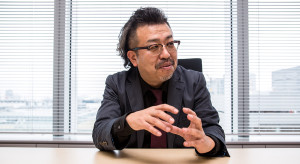
As the new general manager of the Global Research & Innovative Technology Center (GRIT) at Hitachi Metals, Kenichi Inoue is tasked with creating an updated framework for research and development in advanced materials, helping his organization make the shift to a new approach to engineering and innovation in a disrupted world.
With products that include both basic materials and finished products used in automobiles and electronics, Hitachi Metals has established GRIT as a research facility that accelerates the production of advanced materials by using new technologies such as artificial intelligence and computer-generated materials informatics.
To do this, Inoue and his team at GRIT are preparing to work in new ways, both inside the organization and with outside partners, to create products as the company looks to the electric vehicle, aircraft and energy sectors for future revenue streams.
This is a big step for Hitachi Metals. The company is a member of the Hitachi Group, listed on the first section of the Tokyo Stock Exchange, and enjoys an A+ credit rating and stable outlook from Ratings & Investment Information Inc.
But Inoue says the shift, which will involve finding fresh ways for researchers to work with organizations to bring new products to market, is crucial for the company’s future.
“Continuous innovation is easy to pursue, but GRIT has been established as a venue for non-continuous, disruptive innovation, in the face of rapidly accelerating technological developments,” says Inoue.
The GRIT team’s ongoing projects include developing the materials used in 3D printers by creating computer programs that allow simulation of how metals may change during the output process.
The development of such materials will call for deeper research into non-metallic areas, which might appear to pose a threat to Hitachi Metals’ core business. But innovations in this area could be a launchpad for major business opportunities in new fields for the company.
To expand the company’s horizons, Inoue is looking to actively cooperate with both clients and external parties, via a process known as Open Innovation.
Hitachi Metals is a founding member of the IBM Research Frontiers Institute, an open research consortium engaged in an array of state-of-the art research topics, including revolutionary computing technologies such as quantum computing, neuromorphic devices – which help computers recognize complex, unstructured data patterns – and bio-devices.
GRIT has dispatched young researchers to the Institute hoping they can take advantage of the open working environment. Inoue is enthusiastic about the flatter organizational hierarchy that he witnessed on his visits there.
“Our staff tells me that it is very easy to communicate with their peers. I want to take the lead, and see this atmosphere thoroughly penetrated throughout GRIT,” Inoue says.
Inoue has taken out the traditional meeting rooms at GRIT and replaced them with glass-enclosed spaces, to highlight transparency, a contrast with many Japanese companies where meeting rooms often are small capsules.
Inoue himself has no separate office, instead working from a variety of stations at locations around the facility.
“I do not need an office. I can work and have discussions wherever I go. I’d like to think I’m breaking down the existing hierarchy by doing so,” he says.
High on Inoue’s agenda is the need to understand how to commercialize research innovation. Researchers tend to submerge themselves in their work without considering the commercial possibilities. But using Hitachi Metals’ new Strategic Innovation Department to liaise between GRIT, clients and outside research partners, it has been possible to enhance efforts on all levels, Inoue says.
The venue for such research is the Open Lab, where the GRIT team works with clients to resolve issues and create demands. The goal is to establish an “intelligent community” including clients and other companies to find new opportunities.
“We often find applications for our research through communications with our clients,” Inoue says. To learn more click here.








You must be logged in to post a comment.